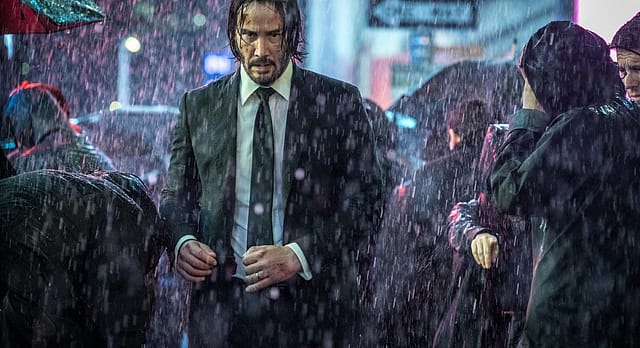John Wick: Chapter 3 - Parabellum

The parabellum pistol is a semi-automatic weapon originating in Germany. It is also the Latin for the command: ‘prepare for war’. This is just one of the many plays on set paradigms used in the third installation of the ‘John Wick’ series of action films. When John Wick’s final tableau begins, the manager of the Continental Hotel in New York, Winston (Ian McShane) pours out a glass of wine for himself and asks his elegant concierge, Charon (Lance Reddick), to open his personal armoury and to offer John Wick (Keanu Reeves) his choice of weapons. Then he plays classical music. It is Antonio Vivaldi’s ‘Four Seasons’ (Winter) that overwhelms the sound track when war begins at the Continental.
High culture is mixed with the low tradition of violence, but the second was probably necessary to achieve and sustain the first, wasn’t it? Our elegant way of life is paved with bloodshed. The opening of the film plays on a similar theme of low and high culture. There is a bounty out for the killing of John Wick, and all the low life of New York is out to get it. Wick goes into the New York Public Library and asks for 'Russian Folk Tales, Aleksandr Afanasyev, 1864’. An assassin comes to kill him at the bookshelf aisle, but Wick kills him instead by thrashing him with the book. He then carefully returns it to the correct shelf, maintaining proper library decorum. The meaning is clear. The would be murderer is not left with his head buried in a book. He is sent to meet the author.
The paradoxical paradigms gets even funnier. ‘The High Table’ in the movie is the association of assassins that is controlling New York City. We hear a lot about these foreboding people. The plot centres on it because John Wick has earlier (in part 2) been excommunicated by the High Table. Now 'the high table' at Oxford, Cambridge and a few other distinguished universities in the United Kingdom, is an elevated platform where the faculty, assorted fellows, and their personal guests dine. The students are all seated at the low tables below. Even a brief association with academia will tell you that the high table is exactly that - an association of assassins who murder all creativity, research and good assignments. Freedom of independent thought is destroyed by an excommunication issued from the high table.
Ordinarily, of course, an excommunication is an ecclesiastical term, meaning that a person is forbidden to perform the sacraments and services of the Church. ’The High Table’, either in New York City or at Oxbridge, is hardly a place of worship. But hey, you could discuss the violence of the Church that achieved the high points of Christian civilisation!
Anyway, the plot thickens. John Wick travels to Casablanca, is left in a desert, then has to sacrifice his ring finger (with his wedding ring on it) for a chance to get back to New York. He reaches Grand Central Station, and in a scene reminiscent of the Union Station sequence in Brian De Palma's ‘The Untouchables’, he is welcomed by a hit team, but has to be careful not to hurt the transit passengers. These new assassins, all apparently of East Asian extraction, are deeply respectful of John Wick, wait for the children to pass, and would rather challenge him in a battle of martial arts, than kill him outright. The leader of this gang is finally impaled by Wick, but is so respectful that he says he enjoyed the good fight. Then he dies.
The fight choreography is excellent and bullet craft is mixed with knife throwing, book banging, kung fu and even dog attacks. This is not real violence, and the background music and sound effects, underlines this. Nor is it an unbelievable superhero action story. It is highly co-ordinated ballet-like movements worked out in synchrony.
What is nice is that there is a thought process and a sense of humour that permeates John Wick, part 3. The film is a good, one time, popcorn watch. The references are amusing, but there is not that much more to say about it.
